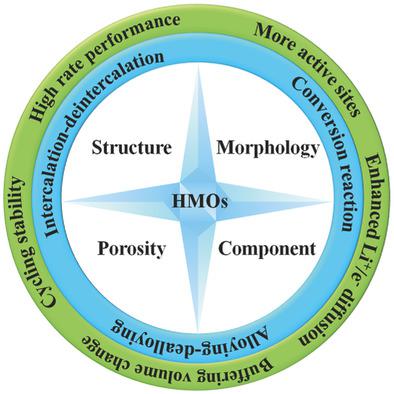当前位置:
X-MOL 学术
›
Small Methods
›
论文详情
Our official English website, www.x-mol.net, welcomes your feedback! (Note: you will need to create a separate account there.)
Hierarchy Design in Metal Oxides as Anodes for Advanced Lithium‐Ion Batteries
Small Methods ( IF 12.4 ) Pub Date : 2018-08-23 , DOI: 10.1002/smtd.201800171 Jun Jin 1, 2 , Liang Wu 1 , Shaozhuan Huang 1, 3 , Min Yan 1 , Hongen Wang 1 , Lihua Chen 1 , Tawfique Hasan 4 , Yu Li 1 , Bao-Lian Su 1, 5, 6
Small Methods ( IF 12.4 ) Pub Date : 2018-08-23 , DOI: 10.1002/smtd.201800171 Jun Jin 1, 2 , Liang Wu 1 , Shaozhuan Huang 1, 3 , Min Yan 1 , Hongen Wang 1 , Lihua Chen 1 , Tawfique Hasan 4 , Yu Li 1 , Bao-Lian Su 1, 5, 6
Affiliation

|
Hierarchical structures are ubiquitous in both animals and plants. The coordination of the hierarchical structures and functions makes living organisms function efficiently. This explains why hierarchical metal oxide (HMO)‐based micro/nanostructures have recently received huge attention as anodes for application in highly efficient lithium‐ion batteries (LIBs). Indeed, hierarchy in such micro/nanostructured HMOs offers high specific surface area, stable structure, short path length, and improved higher packing density to improve the reaction kinetics and Li+/e− transport kinetics, resulting in highly enhanced rate capability and cycling stability for LIBs. This report focuses on the hierarchical design from structural, morphological, porous, and component levels to engineer the HMOs as anodes for LIBs. The advantages of micro/nanostructured HMO‐based on three reaction mechanisms (intercalation/deintercalation, conversion, and alloying/dealloying), important challenges ahead, and future perspectives on designing advanced electrode materials for next‐generation high‐performance LIBs are discussed.
中文翻译:

用作高级锂离子电池阳极的金属氧化物的层级设计
层级结构在动植物中无处不在。层次结构和功能的协调使活生物体有效发挥功能。这解释了为什么基于分层金属氧化物(HMO)的微/纳米结构作为用于高效锂离子电池(LIB)的阳极最近受到了广泛的关注。实际上,在分层结构这样的微/纳米结构的HMO提供了高的比表面积,稳定的结构,短路径长度,和改进的高填充密度,以提高反应动力学和Li + / E -运动力学,从而大大提高了LIB的速率能力和循环稳定性。本报告重点关注从结构,形态,多孔和组件级别的分层设计,以设计HMO作为LIB的阳极。讨论了基于三种反应机理(插层/脱嵌,转化和合金化/脱合金)的微/纳米结构HMO的优势,未来的重大挑战,以及为下一代高性能LIB设计先进电极材料的未来前景。
更新日期:2018-08-23
中文翻译:

用作高级锂离子电池阳极的金属氧化物的层级设计
层级结构在动植物中无处不在。层次结构和功能的协调使活生物体有效发挥功能。这解释了为什么基于分层金属氧化物(HMO)的微/纳米结构作为用于高效锂离子电池(LIB)的阳极最近受到了广泛的关注。实际上,在分层结构这样的微/纳米结构的HMO提供了高的比表面积,稳定的结构,短路径长度,和改进的高填充密度,以提高反应动力学和Li + / E -运动力学,从而大大提高了LIB的速率能力和循环稳定性。本报告重点关注从结构,形态,多孔和组件级别的分层设计,以设计HMO作为LIB的阳极。讨论了基于三种反应机理(插层/脱嵌,转化和合金化/脱合金)的微/纳米结构HMO的优势,未来的重大挑战,以及为下一代高性能LIB设计先进电极材料的未来前景。



























 京公网安备 11010802027423号
京公网安备 11010802027423号